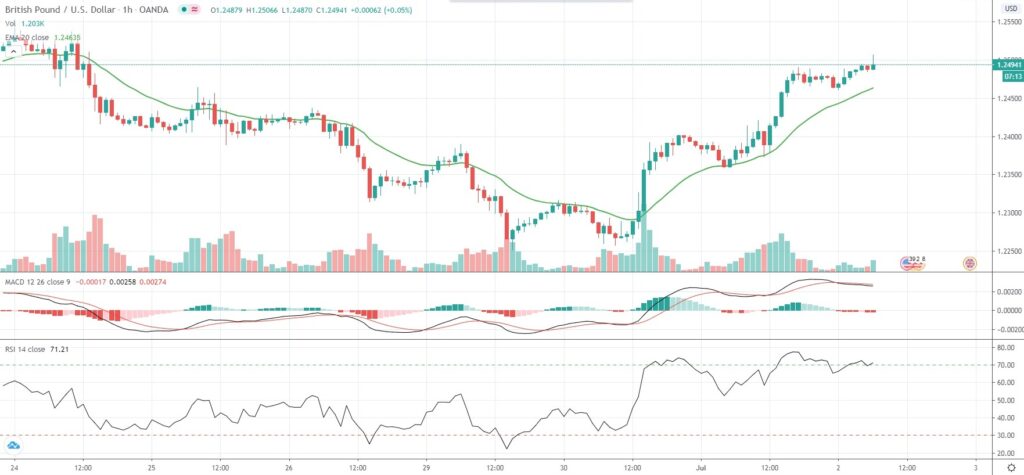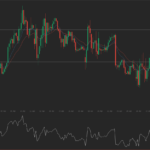GBP/USD extended gains from the prior two trading days on Thursday and touched a fresh one-week high on the back of weaker US Dollar and macro data-driven optimism. However, market players abstained from more aggressive risk taking amid surging new coronavirus infections and ahead of the key US Non-Farm Payrolls report.
Yesterday the Institute for Supply Management said US manufacturing activity had rebounded sharply in June, with the PMI pointing to the strongest expansion since April 2019, while a report by ADP showed US private sector companies had hired 2.369 million workers in June, following a revised up jobs gain of 3.065 million in May.
Business surveys from China and the Euro Area also indicated improving factory activity in June.
Meanwhile, operating conditions in UK’s manufacturing sector stabilized in June, latest data by Markit showed, after a sharp downturn due to the pandemic. Manufacturing production grew slightly for the first time in four months in June, while new orders and employment decreased at a softer rate.
Market sentiment was also supported by news that a COVID-19 vaccine, co-developed by BioNTech and Pfizer, showed potential in early-stage human trials.
Against that backdrop, however, new confirmed cases of the illness across the United States continued to rise. New COVID-19 infections were reported at almost 50,000 on Wednesday, which has been the sharpest single-day surge since the start of the pandemic.
As of 6:54 GMT on Thursday GBP/USD was edging up 0.17% to trade at 1.2496, after earlier touching an intraday high of 1.2507, or a level not seen since June 24th (1.2543). The major pair has advanced 1.28% so far this week, following three successive weeks of losses.
The Pound is projected to appreciate towards the end of 2020, in case the European Union and Britain manage to come to an agreement over their future trading relationship.
“Our central scenario is that some kind of Brexit deal or delay will be agreed. With this in mind, we think sterling will rise, however, given recent developments, the risks to our forecasts are to the downside,” Simona Gambarini of Capital Economics said.
Today’s market focus will be on the more comprehensive non-farm payrolls report, which reflects employment in US public and private sectors. Employers in all segments of US economy, excluding the farming industry, probably added 3,000,000 new jobs in June, according to market expectations, after a job gain of 2,509,000 in May. The latter has been the largest monthly job growth rate on record, as employment increased sharply in leisure and hospitality, construction, education and health services, as well as in retail trade.
Meanwhile, the rate of unemployment in the country probably decreased to 12.3% in June, according to a consensus of estimates, from 13.3% in May. The official government report is due out at 12:30 GMT.
A separate report by the Bureau of Economic Analysis at 12:30 GMT may show US trade deficit widened to $53 billion in May from $49.4 billion in April. The latter has been the largest trade gap since August 2019, in part due to the impact of the pandemic, with many businesses being forced to operate at limited capacity or to cease operations entirely.
Also at 12:30 GMT, the US Labor Department will release its weekly report on jobless claims. The number of people in the country, who filed for unemployment assistance for the first time during the business week ended June 26th, probably eased to 1,355,000, according to expectations, from 1,480,000 in the preceding week. The latter exceeded the peak observed during the 2007-2009 financial crisis more than twice.
At 16:00 GMT Bank of England is scheduled to publish its Financial Stability Report. After an unanimous vote, the key bank rate was kept intact at the record low level of 0.1% at the bank’s policy meeting on June 18th. Members of the Monetary Policy Committee also voted by a majority of 8-1 in favor of raising the target stock of purchased UK government bonds by GBP 100 billion to a total of GBP 745 billion.
Bond Yield Spread
The spread between 2-year US and 2-year UK bond yields, which reflects the flow of funds in a short term, equaled 23.4 basis points (0.234%) as of 6:15 GMT on Thursday, down from 24.1 basis points on July 1st.
Daily Pivot Levels (traditional method of calculation)
Central Pivot – 1.2442
R1 – 1.2524
R2 – 1.2573
R3 – 1.2655
R4 – 1.2737
S1 – 1.2393
S2 – 1.2311
S3 – 1.2262
S4 – 1.2213






